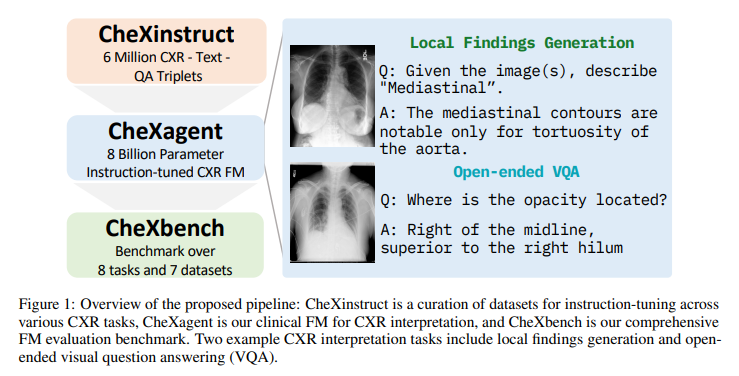Researchers from Stanford Introduce CheXagent: An Instruction-Tuned Foundation Model Capable of Analyzing and Summarizing Chest X-rays


Artificial Intelligence (AI), particularly through deep learning, has revolutionized many fields, including machine translation, natural language understanding, and computer vision. The field of medical imaging, specifically chest X-ray (CXR) interpretation, is no exception. CXRs, the most frequently performed diagnostic imaging tests, hold immense clinical significance. The advent of vision-language foundation models (FMs) has opened new avenues for automated CXR interpretation, potentially revolutionizing clinical decision-making and enhancing patient outcomes.
The primary challenge in developing effective FMs for CXR interpretation lies in the limited availability of large-scale vision-language datasets, the complexity of medical data, and the absence of robust evaluation frameworks. Traditional methods often fail to capture the nuanced interplay between visual elements and their corresponding medical interpretations. This gap in capability hinders the development of models that can accurately interpret medical images like CXRs.
Researchers from Stanford University and Stability AI have introduced CheXinstruct, a comprehensive instruction-tuning dataset curated from 28 publicly available datasets. This dataset is specifically designed to improve the ability of FMs to interpret CXRs accurately. Concurrently, the researchers developed CheXagent, an instruction-tuned FM for CXR interpretation, with an impressive 8 billion parameters. CheXagent is a culmination of a clinical large language model (LLM) capable of understanding radiology reports, a vision encoder for representing CXR images, and a bridging network to integrate the vision and language modalities. This integration enables the FM to analyze and summarize CXRs effectively.
CheXbench was introduced to evaluate the effectiveness of these models. CheXbench enables systematic comparisons of FMs across eight clinically relevant CXR interpretation tasks. It assesses the models’ capabilities in image perception and textual understanding, providing a comprehensive evaluation framework. CheXagent’s performance in these tasks was exceptional, demonstrating its superiority over general- and medical-domain FMs.
CheXagent outperformed general-domain FMs substantially, showcasing its advanced capabilities in understanding and interpreting medical images. The model showed remarkable proficiency in tasks like view classification, binary disease classification, single and multi-disease identification, and visual question answering. In textual understanding, CheXagent excelled in generating medically accurate reports and summarizing findings, as validated by expert radiologists.
The evaluation also included a fairness assessment across sex, race, and age to identify potential performance disparities, contributing to the model’s transparency. This comprehensive analysis revealed that CheXagent, while superior in performance, still has room for improvement, especially in aligning its outputs with human radiologist standards.
In conclusion, the development and implementation of CheXagent mark a significant milestone in medical AI and CXR interpretation. The combination of CheXinstruct, CheXagent, and CheXbench represents a holistic approach to improving and evaluating AI in medical imaging. The results from these models demonstrate their potential to enhance clinical decision-making and highlight the ongoing need to refine AI tools for equitable and effective use in healthcare. The public release of these tools underscores a commitment to advancing medical AI and sets a new benchmark for future research in this vital area.
Check out the Paper. All credit for this research goes to the researchers of this project. Also, don’t forget to follow us on Twitter. Join our 36k+ ML SubReddit, 41k+ Facebook Community, Discord Channel, and LinkedIn Group.
If you like our work, you will love our newsletter..
Don’t Forget to join our Telegram Channel
The post Researchers from Stanford Introduce CheXagent: An Instruction-Tuned Foundation Model Capable of Analyzing and Summarizing Chest X-rays appeared first on MarkTechPost.
Credit: Source link


Comments are closed.